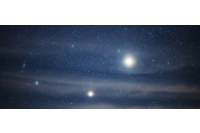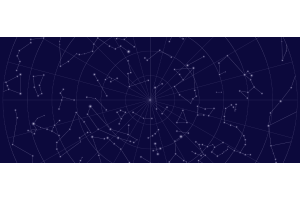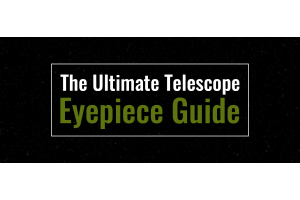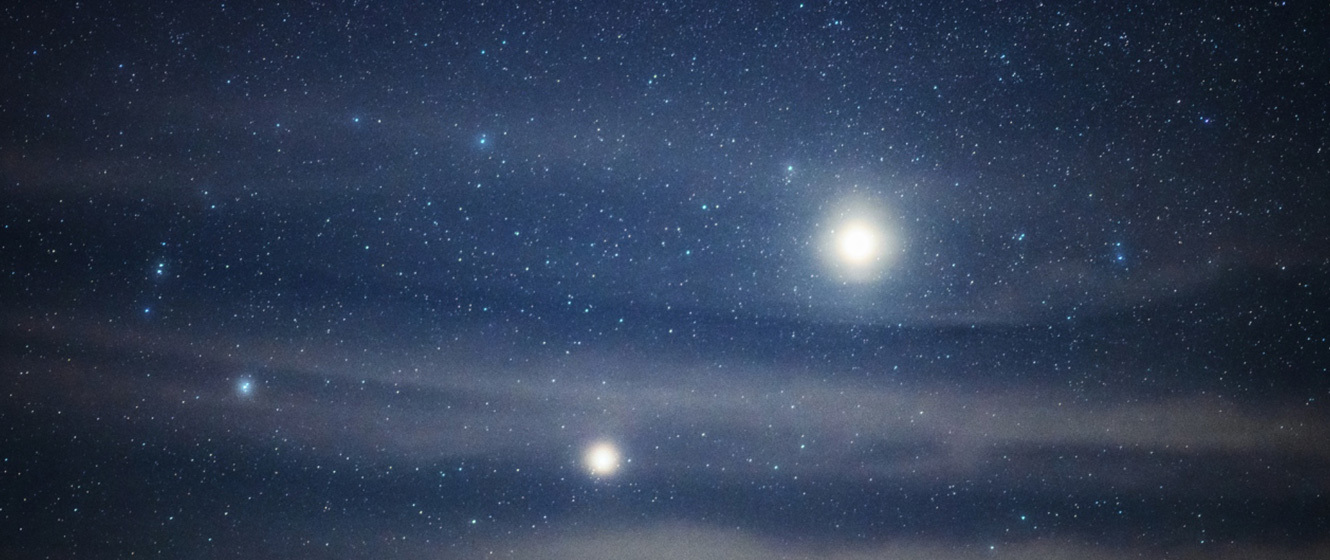
2020 Astronomical Calendar
Every year brings its own celestial highlights and 2020 promises to provide us with some outstanding sights. From close encounters with Venus, a particularly favorable opposition of Mars, penumbral lunar eclipses and a rare conjunction of Jupiter and Saturn, 2020 has it all.
NOTE: Although these descriptions are written primarily for observers in North America, many of the sights can be seen throughout the world. Check online or local periodicals for details specific to your location.
January
January 3rd, Quadrantid Meteor Shower
The new year always starts with fireworks, and the night sky is no exception. The Quadrantid meteors are usually some of the best and the shower is known to produce some fireballs. The light from a waxing gibbous Moon might drown out some of the fainter meteors, but once the Moon sets (at around midnight) you’ll have a better chance of catching some shooting stars.
January 10th, Full Moon and Penumbral lunar eclipse
The first full Moon of the year, also known as the Wolf Moon, comes with an added bonus this year. Penumbral eclipses occur when the Moon passes through the outer part of the Earth’s shadow, and are relatively rare events. Unfortunately, although we’re treated to four in 2020, the first is best seen from Europe and Asia. If you live in the far north-eastern part of North America, you may be able to catch the end of the eclipse at moonrise, but as the eclipse is nearing its end, you probably won’t notice much difference at all!
January 16th, Conjunction of Mars and Antares
Mars is passing Antares in the morning sky, and while the conjunction isn’t a particularly close one (five degrees separate the planet and star) it provides a good opportunity to compare the two. The name Antares means “rival of Mars” because its color is said to be similar. The pair should be easily seen in the southeast, about 45 minutes before sunrise. Take a look for yourself; which is brighter and which is redder?
January 20th, Conjunction of the Moon and Mars
Look to the south-east before dawn and you’ll see a crescent Moon close to Mars and Antares. Mars will appear just to the lower left of the Moon, while Antares will be about twice the distance and to its lower right. If you have a clear view of the horizon, you might also be able to spot Jupiter against the twilight.
January 27th, Conjunction of Venus and Neptune
You have a rare opportunity to see Venus pass by Neptune this evening. Venus is a brilliant, naked eye planet, but you’ll definitely need binoculars or a small telescope to spot its distant sibling. Wait until about two hours after sunset and then turn to the west to see Venus. Once you’ve got the planet in your binoculars, you should be able to see a relatively faint, blue star just to its lower right. That’s Neptune, the most distant planet from the Sun. And that yellow-gold star just above Venus? That’s Phi Aquarii. Together, with brilliant-white Venus, the trio should make for a very nice color contrast.
February
February 9th, Full Moon
February’s full Moon is called the Snow Moon, as this is the month when the snow tends to fall the most. Tonight, the Moon appears close to Regulus, the brightest star in the constellation of Leo, the Lion. Being a full Moon, the Moon will rise at about sunset and then set at about sunrise, with Regulus appearing to its right.
February 10th, Mercury at Greatest Eastern Elongation
Mercury is at its furthest from the Sun in the sky today, and this is a good opportunity to try and spot the tiny planet in the evening sky. Unfortunately, there’s no bright Moon nearby, but brilliant Venus hangs in the twilight some way to the upper left. To see Mercury, you’ll need a clear, unobstructed view of the western horizon. Try looking about twenty or thirty minutes after sunset - you may be able to spot a pinkish-white star about a third of the height of Venus above the horizon. If you can’t see it, there’ll be other opportunities in June and September.
February 18th, Occultation of Mars by the Moon
This year has a number of excellent planetary close encounters, and this is one of the best. Many observers in North America will be able to see the crescent Moon occult, or cover, the planet Mars in the predawn sky. You won’t need binoculars to enjoy the event, but they’ll definitely improve the view. The actual timing of the event will vary, depending upon your location, but most cities should see at least the disappearance of the planet. See the International Occultation Timing Association for timings specific to your city.
February 19th, Conjunction of the Moon and Jupiter
Now it’s Jupiter’s turn to be visited by the waning crescent Moon. You’ll find the yellow-gold planet just to the left of the Moon in the pre-dawn twilight. If you look toward the south-east, at about thirty minutes before dawn, you’ll see Mars, Jupiter and Saturn in a line above the horizon, with the Moon close to the middle of the line.
February 20th, Conjunction of the Moon and Saturn
Lastly, if you didn’t spot Saturn yesterday, you’ll have another opportunity this morning. Once again, look to the south-east at about thirty minutes before sunrise, and you’ll see the crescent Moon just below it and a little to the planet’s right.

March
March 9th, Conjunction of Venus and Uranus
Having passed Neptune at the end of January, Venus now passes the seventh planet, Uranus. Again, you’ll be able to easily spot Venus in the evening sky, but you’ll need binoculars for the fainter, more distant planet. Wait until about 90 minutes after sunset and then look to the west for Venus. Uranus should appear to the lower left of Venus, in the eight o’clock position, within the same binocular field of view.
March 9th, Full Moon
The Moon is closest to the Earth tomorrow, but turns full today. This means we have a “Supermoon” - but will you actually see anything different? Realistically, no - on average, the Moon appears about 31 arcseconds in size, or slightly more than half a degree. This full Moon is 33.8 arcseconds, or roughly 9% larger. The difference is too small to be noticed by your eyes. The March Moon is also called the Worm Moon, as it signals the return of earthworms as the weather warms.
March 20th, Conjunction of Mars and Jupiter
Time for another planetary encounter, but we’re back to the morning sky. Mars and Jupiter are now very close together and will appear above the south-eastern horizon before sunrise. Jupiter is the brighter of the pair and will appear as a yellow-ish star to the upper left of fainter, coppery colored Mars. About 42 arcseconds will separate the planets, or less than the width of two full Moons. Speaking of the Moon, you can catch it close to the horizon, while Saturn appears to the left of the planetary pair.
March 21st, Conjunction of the Moon and Mercury
Mercury reaches greatest western elongation on the 24th. That’s when it's furthest from the Sun in the sky, but you might have a better chance of spotting it this morning. A waning crescent Moon, just three days from turning new, appears to the planet’s lower right in the predawn sky. You’ll need a clear, unobstructed view of the eastern horizon and you won’t have much time before the sky brightens. Start looking about twenty minutes before sunrise; if you have them, use binoculars to help your search.
March 31st, Conjunction of Mars and Saturn
Just as Mars passed Jupiter on the 20th, so it now appears close to Saturn this morning. The gap is slightly larger today than it was then, and Saturn is fainter than Jupiter, but their colors should provide a nice contrast. Look toward the south-east at about 45 minutes before sunrise; Saturn is the higher, pale, white-ish star while Mars is to its lower right. Both are almost the same brightness; Saturn shines at magnitude 0.7, while Mars is slightly fainter at 0.8.
April
April 3rd, Conjunction of Venus and the Pleiades
This is, perhaps, the best that Venus has to offer this year. Still a brilliant sight in the evening sky after sunset, you’ll find the planet passing among the stars of the Pleiades star cluster tonight. You can see both with just your eyes, but aim your binoculars toward the planet and you’ll see something quite stunning. Venus, as always, will be a brilliant, white point of light, while the fainter stars of the cluster will appear blue-white. They’ll still be close tomorrow, but it won’t look as good as tonight, so don’t miss out!
April 7th, Full Moon
April’s full Moon is known as the Pink Moon, thanks to the pink phlox flowers that bloom this month. It’s another supermoon - the second of three this year - and this one is the closest that 2020 has to offer. The Moon is closest to the Earth (called perigee) at 6:08pm Universal Time (2:08pm Eastern Time) and then turns full about seven hours later. It’s among the stars of Virgo tonight, but the light of the Moon will brighten the sky and drown out almost all the nearby stars. Look out for Spica, the brightest star in Virgo, to its lower right.
April 14th, Conjunction of the Moon and Jupiter
The Moon has returned to the morning sky and can now be found close to Jupiter. Now at last quarter, it hangs to the right of the giant planet, with Saturn to the left of Jupiter and Mars to the left of the ringed world. Come back on the 15th and 16th to see the slimming Moon close to Saturn and then Mars in the predawn twilight.
April 22nd, Lyrid Meteor Shower
It’s been over three months since our last major meteor shower, so we’re long overdue for some shooting stars. The Lyrids are bright and under ideal conditions, you could expect to see about 18 an hour. Fortunately, it’s a new Moon today so the chances of seeing a few are pretty good. If you want to increase your chances, wait until after midnight, when the constellation of Lyra will be rising over the north-eastern horizon.

May
May 5th, Eta Aquariid Meteor Shower
Just a couple of weeks after the Lyrids, we have the Eta Aquariid meteors and while these meteors are also fairly bright, you might not be so lucky this time. The reason is the Moon; it’s nearly full tonight and will brighten the sky considerably. As a result, you might not be able to see some of the fainter shooting stars. These meteors appear to radiate out from the constellation of Aquarius, the Water Bearer, which won’t rise until about an hour before sunrise, just as the troublesome Moon is setting.
May 7th, Full Moon
May’s full Moon is known as the Flower Moon, in honor of the many flora that will be flowering this month. It’s also the third and last “supermoon” of the year and the most distant, as the Moon is closest on May 6th at 3:05am Universal Time (that’s 11:05 pm on May 5th, Eastern Time.) It’s passing through the faint stars of Libra, the Scales, and the chances are you won’t see anything of the constellation itself. Look someway toward the left instead - do you see red Antares, the beating heart of Scorpius, the Scorpion? It’s bright enough to shine through the moonlight.
May 12th, Conjunction of the Moon, Jupiter and Saturn
Jupiter and Saturn are drawing closer together and are still best seen in the predawn sky. You’ll find the waning gibbous Moon below Jupiter over the southern horizon this morning, with Saturn just to its left. Meanwhile, the distance between those two planets and Mars continues to grow. You’ll find it over the south-eastern horizon, with the crescent Moon appearing nearest the red planet on the 15th.
May 21st, Conjunction of Mercury and Venus
Mercury reaches greatest eastern elongation from the Sun on June 4th, but you’ll find it close to Venus in the evening twilight tonight. Of the two, Venus should be easier to see. Although it’s losing ground to the Sun, it’s still visible as a brilliant star toward the south-west shortly after sunset. Keep looking and you should soon see a fainter, pinkish-white star just to the lower left of Venus - that’s Mercury. If you spot it, give yourself a pat on the back - there are some who go their entire lives without seeing the planet at all!
May 27th, Conjunction of the Moon and the Beehive cluster
This could be a little challenging, and you’ll definitely need binoculars to see anything of the cluster. The Moon is now a waxing crescent, and although it can be seen in the evening sky, you’ll need to wait until the sky is truly dark to properly see the cluster. Unfortunately, that won’t happen until about two hours after sunset, when both the Moon and cluster are fairly low in the sky. Grab your binoculars and place the Moon near the edge of your field of view, in about the eleven o’clock position. Now look toward the five o’clock position - do you see a small smattering of stars? That’s the Beehive.
June
June 4th, Mercury at Greatest Eastern Elongation
Mercury is now at its greatest distance from the Sun in the sky and is best seen in the evening twilight. Unfortunately, Venus has now vanished from the evening sky and the Moon is nowhere to be seen, so spotting the planet might be a little tricky. On the plus side, Mercury should be relatively easily seen until at least an hour after sunset, and if you’re familiar with the stars Castor and Pollux, the two brightest stars of Gemini, the Twins, you could use them as a guide. Look to the west, about 45 minutes after sunset. If you can see two reasonably bright stars, fairly close together in a horizontal line, then you’ve found Castor and Pollux. Look directly below Castor, the star on the right, for pinkish-white Mercury. It’ll be about a third of the height of Castor above the horizon.
June 5th, Full Moon
June’s full Moon is known as the Strawberry Moon, as this month is the best for that favorite fruit. It’s midway between the constellations of Scorpius, the Scorpion, and Sagittarius the Archer, and at its lowest point for the year. As such, after rising in the south-east at sunset, it’ll skim the southern horizon and then set in the south-west at sunrise. Look for Antares, the brightest star in Scorpius, some way to its right. There’s also a penumbral lunar eclipse, the second of the year, that begins at 17:45 Universal Time. While most of the world will have the opportunity to witness this event, anyone in either North or South America will be out of luck.
June 12th, Conjunction of Mars and Neptune
Here’s another Neptunian binocular conjunction for you. After being passed by Venus in the January evening sky, it’s now visited by the red planet Mars in the morning sky. Both will appear within the same binocular field of view, and while they’re visible in the predawn twilight, you’ll need to get up several hours before sunrise to stand a good chance of spotting Neptune. Being the faintest planet, it’ll fade against the brightening sky of dawn fairly quickly, so the darker your skies, the better your chances. Neptune will appear as a sapphire-like blue star to the upper left of the red planet.
June 19th, Conjunction of the Moon and Venus
Venus has left the evening sky behind and has emerged from the glare of the Sun and into the predawn sky. You’ll find the waning crescent Moon just to its lower left this morning. Look to the east from about 45 minutes before sunrise.

July
July 4th/5th, Full Moon and Penumbral Lunar Eclipse
This month’s full Moon is known as the Buck Moon, as the antlers of male deer start to grow at this time. Technically, the full Moon occurs in the early hours of the 5th, but for observers in North and South America there’s a penumbral lunar eclipse on the evening of the 4th. It begins at 11:07pm Eastern Time and reaches its maximum some 82 minutes later. As with all penumbral eclipses, the Moon is only partially dimmed, and this eclipse will only reduce the moonlight by some 35%. Can you notice a difference? Either way, the Moon will appear between Jupiter and Saturn and should still be worth seeking out.
July 11th, Conjunction of Venus and Aldebaran
Venus continues to move away from the Sun in the morning sky and now appears close to Aldebaran, the brightest star in the constellation of Taurus, the Bull. The orange-red star represents the eye of the beast and should provide a nice color contrast with the brilliant white light of Venus. Both should easily fit within the same binocular field of view, and if your skies are sufficiently dark enough, you could also see the stars of the V-shaped Hyades star cluster nearby. You’ll find the planet and star toward the east in the pre-dawn twilight.
July 14th, Jupiter at Opposition
Jupiter is at opposition tonight, which means it’s at its best for the year. 2020 is a little unusual in that it has two months where two planets reach opposition, and July is the first of those months. Being at opposition, Jupiter will rise at sunset and be visible throughout the night. It’s among the stars of Sagittarius, the Archer, which means it’ll be low for observers in the northern hemisphere, but that shouldn’t stop you from taking a look. Binoculars will show its four largest moons, but you’ll need a telescope to see the dark belts of its atmosphere.
July 20th, Saturn at Opposition
Just six days after Jupiter reaches opposition, Saturn does the same. Like Jupiter, it’s also in Sagittarius, and although the ringed planet is at its best, it’s considerably fainter than Jupiter. Jupiter shines at a magnificent magnitude -2.8, while Saturn is a dim 0.1. You won’t see much with binoculars, but a small telescope will reveal the planet’s rings and several of its brightest moons.
August
August 1st, Conjunction of the Moon, Jupiter and Saturn
With Jupiter and Saturn both just past opposition and the Moon turning full in only a few days' time, you’ll find all three huddled together in the evening sky tonight. The Moon is, technically, still a waxing gibbous, but it will probably look full to your eyes. Jupiter appears just to its upper right, while Saturn glows to its left.
August 3rd, Full Moon
August’s full Moon is most commonly known as the Sturgeon Moon, as the lakes are often filled with fish at this time of year. Tonight the Moon is among the stars of Capricornus, the Sea Goat. Not a particularly conspicuous constellation, you’ll have difficulty identifying its stars against the moonlit night sky.
August 9th, Conjunction of the Moon and Mars
The waning gibbous Moon now passes close to Mars in the predawn sky, and with just a degree and a half between them, the pair will easily fit within the same binocular field of view. Both will be above the horizon after midnight, but will still be easily visible any time before the dawn.
August 12th, Venus at Greatest Western Elongation
It seemed like just a short time ago that Venus dominated the evening sky, but now it’s moved over into the morning. It shines at a brilliant magnitude -4.3 and is an unmistakable sight in the predawn twilight hours. The waning crescent Moon pays a visit on the 15th.
August 12th, Perseid Meteor Shower
Arguably the most famous meteor shower of them all, the Perseids reach their maximum this evening, and there’s good news and bad news for the shower this year. The good news is that the Moon won’t rise until after midnight, so you should have a good opportunity to catch a few shooting stars in the early evening. The bad news is that the Moon is in Taurus, and not far from where the meteors appear to originate. It only reached last quarter yesterday, so its light might be a little strong for the fainter meteors. They’re typically quite bright though, and under ideal conditions you could see up to 100 an hour, so it’s well worth having a look.
August 15th, Conjunction of the Moon and Venus
Rise a little earlier today to see the waning crescent Moon close to Venus in the morning sky. The pair should make for an attractive sight in the predawn twilight, especially with Earthshine illuminating the Moon. Earthshine is when sunlight is reflected off the Earth and brightens the darkened portion of the Moon’s surface, making the whole of the Moon visible. You can find the pair over the south-eastern horizon, shortly before dawn.
September
September 2nd, Full Moon
The name of the full Moon can change in September, depending upon the date on which it falls. Its traditional name is the Corn Moon, but if it’s the closest full Moon to the fall equinox, then it becomes known as the Harvest Moon. Since the equinox is 19 days away, the Harvest Moon actually occurs in October this year. Tonight, the Moon rises with the faint stars of Aquarius, the Water Bearer.
September 5th, Conjunction of the Moon and Mars
One good thing about the Moon in the autumn months is that the waning gibbous Moon rises before midnight. This means you won’t have to stay up too late, or get up too early, to enjoy today’s conjunction. Go outside at about 10:30pm and you’ll see the Moon rising over the eastern horizon, with coppery Mars to its upper left. Once again, the pair can easily fit within the same binocular field of view.
September 12th, Neptune at Opposition
The most distant planet reaches opposition tonight and is at its best for observation. It’s currently moving through Aquarius, and might be easily mistaken for one of that constellation’s stars. You’ll need binoculars or a telescope to see it and there are a few things that set it apart from its starry background. For starters, it’s unmistakably blue, and when viewed through a telescope with high power, it shows a tiny, but discernible, sapphire disc. If this is your first time observing the planet, your best bet is to use a star chart or a GoTo telescope to help you find it.
September 13th, Conjunction of Venus and the Beehive Cluster
Venus is now moving through the constellation of Cancer, the Crab, and at its heart is the Beehive cluster. Back at the end of May, the waxing crescent Moon was within the same binocular field of view as the cluster, and now it’s the turn of Venus. As this cluster is most easily seen under dark skies, you’ll need to get up about 90 minutes before sunrise and look for Venus over the eastern horizon. If you aim your binoculars toward the planet, you should be able to spot the cluster within the same field of view, at about the ten o’clock position.
September 24th, Conjunction of the Moon and Jupiter
The Moon reached first quarter about a day ago, and has returned to the gas giants of Jupiter and Saturn. You’ll find it just to the lower right of Jupiter in the evening sky. Come back tomorrow and you’ll find it to the left of Saturn.

October
October 1st, Mercury at Greatest Eastern Elongation
Mercury, the innermost and fastest moving planet in the solar system, has once again returned to the evening sky. It’s at its greatest distance from the Sun in the sky today and can be found low over the south-western horizon about thirty minutes after sunset. Unfortunately, there are no bright stars or planets nearby and it’s not at its best, but if you have a clear, unobstructed view of the horizon, you might get lucky.
October 1st, Full Moon
October’s full Moon is usually known as the Hunter’s Moon, as it occurs during hunting season, but 2020 is a little different. October has two full Moons, and with the first being the closest full Moon to the fall equinox, it’s known as the Harvest Moon. You’ll find it in the constellation of Cetus, another faint fall constellation whose stars are sure to vanish against the night sky brightened by the full Moon.
October 2nd, Conjunction of Venus and Regulus
Venus frequently passes by a bright star or planet, but it’s not usually a close conjunction. However, this morning you’ll have the chance to see the planet just 35 arcseconds from Regulus, the brightest star in the constellation of Leo, the Lion. That’s just slightly more than the width of the full Moon, and it should be a splendid sight, whether you’re observing with just your eyes or binoculars.
October 14th, Mars at Opposition
Mars is now at its best for the year and you won’t want to miss this particular opposition. You can, of course, observe the planet with just your eyes, but you’ll get the best views through a telescope. Make the most of this opportunity - Mars won’t appear this bright and this large through a telescope until 2035. The planet is currently moving through Pisces, and with no other bright stars or planets nearby, it’s coppery light is unmistakable. The nearly full Moon appears just below it on the 29th.
October 21st, Orionid Meteor Shower
Tonight it’s the turn of the Orionid meteors to put on a show. While not a major shower (under ideal conditions, you could expect to see about 18 shooting stars an hour) the meteors are fairly bright and, with the waxing crescent Moon setting early, your chances are better than usual.
October 22nd, Conjunction of the Moon, Jupiter and Saturn
There’s a pretty conjunction of the nearly half Moon, Jupiter and Saturn this evening. You can see the trio in the hours after sunset, with the Moon appearing below the two planets and about midway between them. Take a look with a standard set of 10x50 binoculars and all three might just barely squeeze into the same field of view.
October 31st, Full Moon
With the full Moon on the 1st taking the title of Harvest Moon, it’s left to the month’s second full Moon to be known as the Hunter’s Moon. As it’s also the second full Moon of the month, you might also hear it being called a Blue Moon, but, of course, the Moon won’t actually appear that color. Lastly, it’s Halloween, so the Moon will provide some suitably spooky light for any trick or treaters this year.
October 31st, Uranus at Opposition
The last planet to reach opposition this year is Uranus, and while it’s not as spectacular as Jupiter, Saturn or Mars, you should still see more than its more distant sibling, Neptune. It can be found near the stars of Aries, the Ram, and the full Moon also appears nearby tonight. You’ll need at least a pair of binoculars to easily spot it, but a small telescope will reveal a tiny, aquamarine disc with moderate to high power.
November
November 10th, Mercury at Greatest Western Elongation
Mercury has switched sides again and can now be found in the pre-dawn sky. It’s a good time to spot the planet, as it rises more than an hour before the Sun and there are several bright objects nearby. For instance, if you get up about 45 minutes before sunrise this morning, you’ll see a waning crescent Moon above the south-eastern horizon. Someway below that is Venus; draw a line through them both and, about halfway between Venus and the horizon, you might glimpse a pinkish-white star. That’s Mercury - but be careful not to confuse it with Spica, a slightly fainter, white star almost directly below Venus.
November 12th, Conjunction of the Moon, Mercury and Venus
If you had no luck spotting Mercury two days ago, you have another opportunity this morning, as the waning crescent Moon appears just above Venus in the predawn sky. Again, Spica should also be visible just to the lower right of Venus. Come back at the same time tomorrow to see the Moon hanging directly above Mercury. Both will fit within the same binocular field of view, making the tiny planet easier to spot.
November 18th, Conjunction of the Moon, Jupiter and Saturn
Tonight, the waxing crescent Moon appears close to Jupiter and Saturn over the south-western horizon. The Moon is to the lower right of Jupiter, but will skip past both planets over the next twenty-four hours. The two planets are drawing closer and will be closest on the 21st of next month.
November 18th, Leonid Meteor Shower
A meteor shower that’s found a certain amount of fame over the past few years, under ideal conditions the Leonids typically produce about 15 to 20 shooting stars an hour. As the Moon is a waxing crescent this year, it will set early, leaving observers with the remainder of the night to enjoy the shower. As with almost all showers, they’re best seen in the hours after midnight, when the radiant (the point from which the meteors appear to originate) is rising above the eastern horizon.
November 29th/30th, Full Moon and Penumbral Lunar Eclipse
The fourth, and final, penumbral lunar eclipse will be visible throughout western Europe (including the United Kingdom), the Americas, Australia and Asia. This time, the Moon will dip quite some way into the outer edges of the Earth’s shadow, causing its light to dim by roughly 82%. That makes it the best penumbral eclipse for North American observers this year. The eclipse begins at 2:34 a.m. Eastern Time on the 30th (11:34 p.m. Pacific Time, on the 29th), with mid eclipse occuring at 4:43 a.m. ET (1:43 a.m. PT). The eclipse ends at 6:53 a.m. ET (3:53 a.m. PT). This month, November’s Beaver, or Frost Moon, also appears on the outer edge of the Hyades star cluster. Try observing them both with binoculars at mid-eclipse - how many stars can you see?

December
December 12th, Conjunction of the Moon and Venus
With just two days before the Moon turns new, you can catch a glimpse of it close to Venus in the predawn sky this morning. Venus still shines brilliantly against the twilight, with the crescent Moon just to its upper right. Look for the pair over the south-eastern horizon at about 45 minutes before sunrise.
December 13th, Geminid Meteor Shower
The Geminids are one of the best meteor showers and 2020 provides us with an excellent opportunity to enjoy the shooting stars at their best. The Moon turns new tomorrow, so there’ll be no interference from its light. Most of the meteors you’ll see will be of average brightness, but the shower is known to produce the occasional fireball - and with a potential for over a hundred meteors an hour (under ideal conditions) this could become the best shower of the year.
December 16th, Conjunction of the Moon, Jupiter and Saturn
Jupiter and Saturn are almost at their closest, and should already be a fine sight in the evening sky. Just 32 arcseconds, or roughly the width of the full Moon, separates the pair. If you want to see for yourself, you’ll have a crescent Moon close by for comparison. A good set of 10x50 binoculars should fit the Moon and both planets within the same field of view, making this one of the observational highlights of the year.
December 21st, Conjunction of Jupiter and Saturn
Here’s something you won’t see for another 60 years! Jupiter and Saturn have spent the past twelve months drawing closer together and now the pair are at their closest. This is a particularly close conjunction, known as an appulse, and with just 6 arcseconds between them, the pair will almost appear as a single star in the sky. Binoculars or a telescope will enhance the spectacle, with both planets appearing within the same field of view, even at magnifications of over 100x. Don’t wait too long to go outside though; the planets set just a few hours after the sun, giving you a limited window of opportunity to make your observations.
December 23rd, Conjunction of the Moon and Mars
Compared to the splendor of Jupiter and Saturn close together, a conjunction of the Moon and Mars seems almost mundane, but it’s still worth a look. The Moon’s a few days past first quarter, making it a waxing gibbous. You’ll find it below the red planet in the evening sky tonight
December 30th, Full Moon
Known as the Cold or Yule Moon, this month’s full Moon shines brightly among the stars of Gemini, the Twins. Most of the constellation will be lost within the moonlight, but Castor and Pollux, the stars representing the twins themselves, should still be easily visible. This full Moon is the highest of the year for observers in the northern hemisphere and will illuminate the night from sunset to sunrise.
Free Printable Astronomical 2020 Calendar PDF
Note: This is a large file and may take a moment to load. If you are unable to print the PDF from your browser, we suggest opening it in a PDF program.
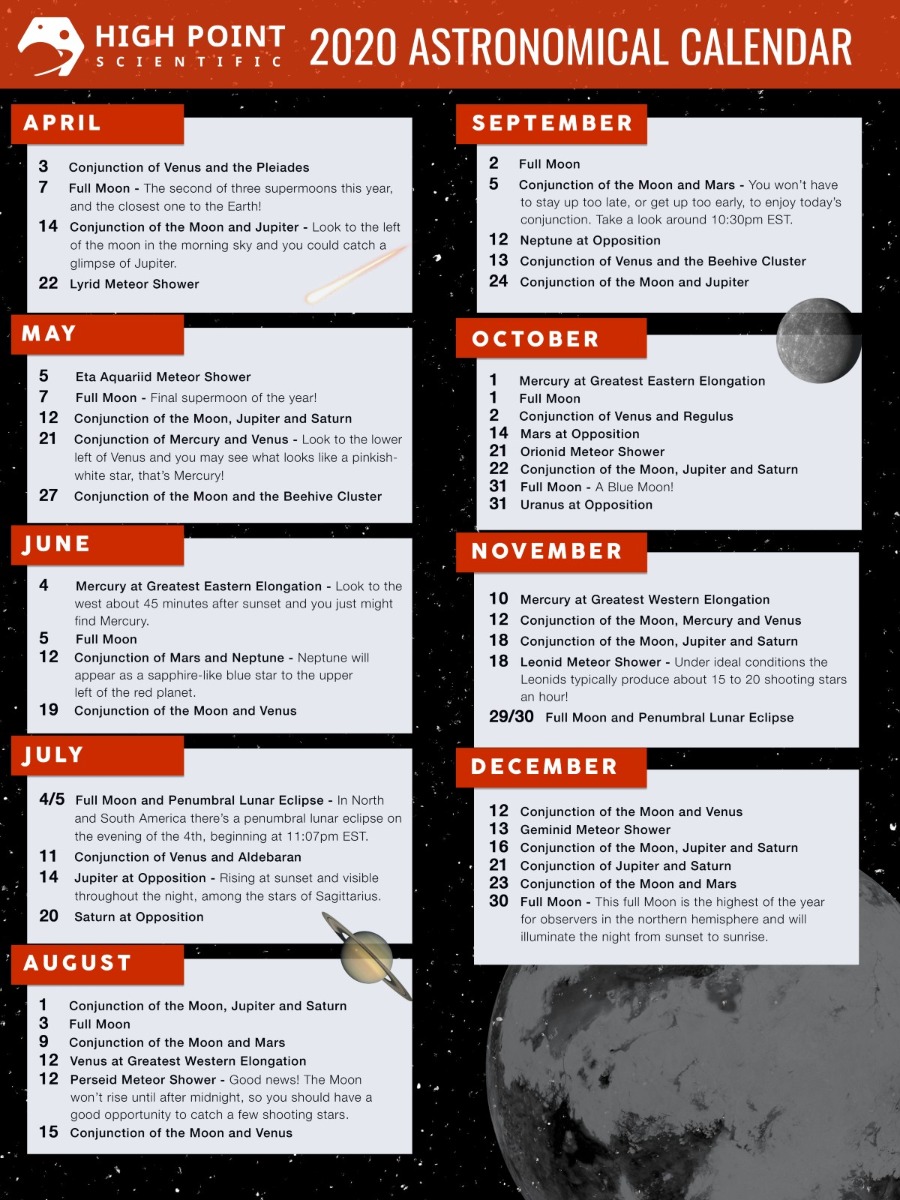 style="margin: 20px auto; margin-left: auto; width: 50%;" />
style="margin: 20px auto; margin-left: auto; width: 50%;" />
This Article was Last Updated on 08/18/2023





